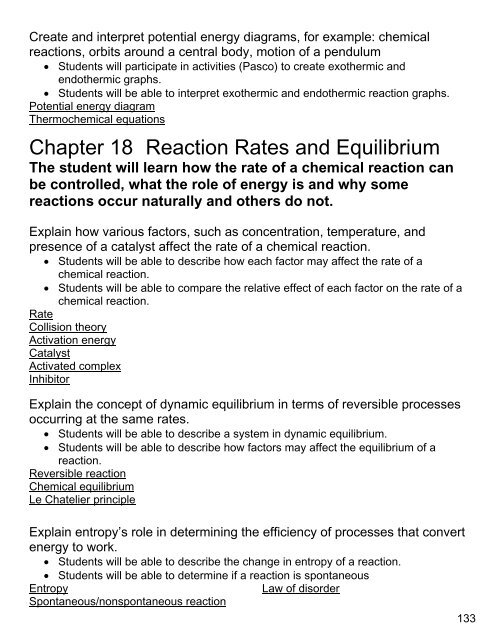You also want an ePaper? Increase the reach of your titles
YUMPU automatically turns print PDFs into web optimized ePapers that Google loves.
The Learning Goal for this assignment is: The Students will learn how the interactions<br />
between water molecules account for the unique properties of water and how aqueous<br />
solutions form.<br />
Take note over the following chapter. Use the Headings provided to organize your notes. Define and number all highlighted vocabulary (total 22 ) as well<br />
as summarize and take notes over the sections. You may add pictures where needed. The pictures should be an appropriate size. Use Arial 12 for all<br />
text. This document should be 2 pages and should be saved as a pdf before you submit it into Angel.<br />
15.1 Water and Its Properties<br />
Chapter 15 Water and Aqueous Systems<br />
Pages 488 - 507<br />
Water in the Liquid State<br />
Key Question: What factor causes the high surface tension, low vapor pressure, and high boiling point of water?<br />
Water is the basis of life, every living thing needs it, it is apparent in the form of solid, gas, and liquid which is always<br />
present in the atmosphere.<br />
Polar molecules are attracted to one another by diploe interactions, the negative end of one molecule attracts to the<br />
positive end of another, in water that attraction results in hydrogen bonding. Hydrogen bonds are attractive forces that<br />
arise when a hydrogen atom is covalently bonded to a very electronegative atom and also weakly bonded to an unshared<br />
electron pair of another electronegative atom.<br />
Many unique and important properties of water- including its high surface tension, low vapor pressure, and high boiling<br />
point- result from hydrogen bonds.<br />
The inward force, or pull, that tends to minimize the surface area of a liquid is called surface tension.<br />
All liquids have a surface tension, but water’s surface tension is higher than most. It is possible to decrease the surface<br />
tension 1 of water by adding surfactant. A surfactant 2 is any substance that interferes with the hydrogen bonding between<br />
water molecules and thereby reduces surface tension.<br />
The vapor pressure of a liquid is the result of molecules escaping from the surface of the liquid and molecules in liquid<br />
water to one another.<br />
Water has a molar mass of 18.0 g/mol, but it has a boiling point of 100 degrees Celsius, the difference between boiling<br />
points of compounds is due to hydrogen bonding, which is more extensive in water than, as shown in the example,<br />
Ammonia.<br />
Water in the Solid State<br />
Key Question: How can you describe the structure of ice?<br />
Water in the liquid state exhibits some unique properties, the same is true for water in the solid state. Ice cubes float in<br />
your glasses of iced tea because solid water has a lower density than liquid water. Why is ice less dense than water?<br />
Hydrogen bonds hold the water molecules in place in the solid phase.<br />
The structure of ice is a regular open framework of water molecules in a hexagonal arrangement.<br />
When ice melts, the framework collapses.<br />
A layer of ice on top of a body of water acts as an insulator for the water beneath, preventing water from freezing solid<br />
except under extreme conditions.<br />
Ice melts at zero degrees Celsius, which is a high melting temperature for a molecule with such a low molar mass.<br />
15.2 Homogeneous Aqueous Systems<br />
Solutions<br />
Key Question: What types of substances dissolve most readily in water?<br />
An aqueous solution 3 is water that contains dissolves substances.<br />
In a solution, the dissolving medium is the solvent. The particles dissolved in a solution are the solute. A solvent 4 dissolves<br />
the solute 5 , and the solute becomes dispersed in the solvent.<br />
Solutions are homogenous mixtures; they are also stable mixtures.<br />
Substances that dissolve most readily in water include ionic compounds and other polar covalent compounds.<br />
Water molecules are constantly in motion; this is because they have kinetic energy.<br />
The process by which the positive and negative ions of an ionic solid become surrounded by solvent molecules is called<br />
solvation 6 .<br />
In some ionic compounds the attractions among the ions in the crystals are stronger than the attractions exerted by water.<br />
Molecules in oil can easily separate and replace molecules in gasoline to form a solution. As a rule, polar solvents such as<br />
water dissolve ionic compounds and polar compounds.<br />
130




